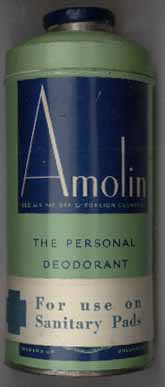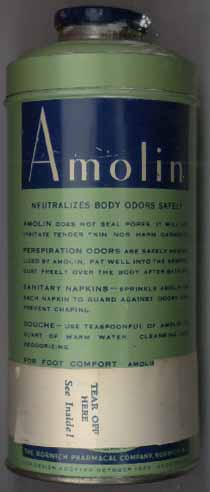See the Kotex Quest
menstrual pad deodorant
|
Amolin, The Personal Deodorant Powder, for
menstrual pads
|
Disguising the odor of menstrual discharge is an important task for women in America and many other countries. Not only is it thought objectionable in itself, the odor lets on that a woman is menstruating, a fact which, for some reason, must be concealed to avoid shame and discrimination. Menstrual huts, on the contrary, advertise that women are menstruating, although they segregate women. (Read what Prof. Sally Price says about menstrual segregation.)But read what really causes menstrual odor - you won't like it.Does our culture conceal menstruation so that women are not segregated - at least for that reason? Why would menstruation require segregation? Why does America so dislike body odor? Why don't I make any money doing this?Amolin powder - it might be baking soda - covered many bases in the odor department: feet, armpits, vagina (by douching with it), menstrual pads, and, the can says, the whole body, actually.In April, 2005, an e-mailer wrote the following:
|
|
Above: front of canSee the white paper band, on the lower part, belowRight: back of can |
|
|
|
|
|
|
|
|
|
|
But read what really causes menstrual odor - you won't like it. See also Australian douche ad (ca. 1900)






